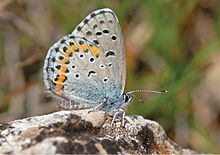Species of butterfly
.mw-parser-output .hidden-begin{box-sizing:border-box;width:100%;padding:5px;border:none;font-size:95%}.mw-parser-output .hidden-title{font-weight:bold;line-height:1.6;text-align:left}.mw-parser-output .hidden-content{text-align:left}@media all and (max-width:500px){.mw-parser-output .hidden-begin{width:auto!important;clear:none!important;float:none!important))You can help expand this article with text translated from
the corresponding article in Russian. (April 2023) Click [show] for important translation instructions.
Machine translation, like
DeepL or
Google Translate, is a useful starting point for translations, but translators must revise errors as necessary and confirm that the translation is accurate, rather than simply copy-pasting machine-translated text into the English Wikipedia.
Do not translate text that appears unreliable or low-quality. If possible, verify the text with references provided in the foreign-language article.
You must provide
copyright attribution in the
edit summary accompanying your translation by providing an
interlanguage link to the source of your translation. A model attribution edit summary is Content in this edit is translated from the existing Russian Wikipedia article at [[:ru:Голубянка бавий]]; see its history for attribution.
You may also add the template ((Translated|ru|Голубянка бавий)) to the
talk page.
For more guidance, see
Wikipedia:Translation.
Pseudophilotes bavius, the Bavius blue, is a butterfly of the family Lycaenidae. It is found in Morocco, Algeria, Bulgaria, Romania, Greece, Asia Minor, southern Russia and northern Kazakhstan.[1] The species occurs in small isolated populations on flower-rich, dry grassland, on dry, stony slopes and on open patches in shrub and in vineyards on calcareous soil.
The wingspan is 24–30 mm. Adults are on wing from April to May and again from June to July in two generations per year. There is usually one prolonged generation a year with adults on wing from late April to mid-July. In Peloponnesus, a partial second generation may occur.[2]
The larvae feed on Salvia species, including S. officinalis, S. nutans, S. verbenaca and S. verticillata. They feed mostly on the flowers, but sometimes also on the leaves. They are frequently found with ants. Hibernation takes place in the pupal stage.[3]
Etymology
Named in the Classical tradition.Bavius was a Roman poet.
